EMSquared Review: Mannatech charity opp spinoff?
 The company name “EMSquared” is derived from the concept of “eradicating malnutrition”, using the “squared” efforts of a group. And with the name explained, you’re pretty much getting the thrust behind the EMSquared opportunity.
The company name “EMSquared” is derived from the concept of “eradicating malnutrition”, using the “squared” efforts of a group. And with the name explained, you’re pretty much getting the thrust behind the EMSquared opportunity.
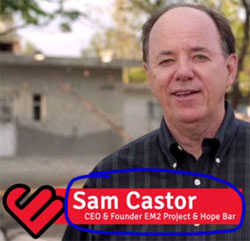 EMSquared are based out of the US state of Texas and headed up by Sam Castor (right), who is credited as CEO and Founder.
EMSquared are based out of the US state of Texas and headed up by Sam Castor (right), who is credited as CEO and Founder.
Castor founded Mannatech in 1993 and served as CEO until his resignation in 2007.
It should be noted at this point that Castor was credited as “Samuel L. Caster” (or just Sam Caster) during his time at Mannatech. Typo or not I can’t say, but he’s being credited as “Sam Castor” in all the EMSquared promotional material I’ve seen.
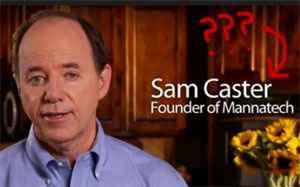 Castor resigned from Mannatech in 2007, amidst ongoing legal and regulatory controversy.
Castor resigned from Mannatech in 2007, amidst ongoing legal and regulatory controversy.
Mr. Caster suggested his own resignation so he could focus on company marketing, said (Mannatech board member) Mr. Larry A. Jobe. Mr. Jobe said the board wasn’t displeased with Mr. Caster, but that the lawsuits gave members ‘a lot of concern.'”
Paperwork filed with the SEC indicate disagreements between Caster and the board of directors were the reason for Caster’s resignation.
The lawsuits mentioned above include a class-action lawsuit filed in 2005 against Mannatech by stock holders. The lawsuit alleged that Mannatech had made
a series of material misrepresentations; specifically: failing to control its sales associates and allowing them to make false claims concerning the efficacy of Mannatech products.
Separately in July 2007, after an investigation that began in October of 2006, Mannatech and Sam Castor were charged by the Texas Attorney General for
operating an illegal marketing scheme in violation of state law.
Mannatech settled the civil complaint on February 26, 2009 by agreeing to pay $4 million in restitution to clients who purchased products and $2 million to the state to cover its costs in the case.
In addition, Sam Caster agreed to pay a $1 million civil penalty.
Castor was no stranger to regulatory action from the Texas AG, with his first two major business ventures having previously attracted their attention too:
Sam Caster’s first major business venture, Eagle Shield, was an insulation product that claimed to utilize new technology developed by NASA and could reduce heating and cooling costs by up to 40%.
The Attorney General of Texas concluded that the product’s technology long predated NASA and did not reduce consumers’ bills in the amounts advertised.
Caster’s second product, the “Electrocat,” was sold as a pest control device. The Electrocat reportedly emitted pulsed vibrations that repelled rats, crickets, snakes, ticks, spiders, mosquitoes, and scorpions.
However, in January 1991, the Attorney General of Texas investigated the product and found that the Electrocat emitted no vibrations whatsoever.
The Attorney General declared, “The device is a hoax, and stands on the same scientific footing as a perpetual motion machine.”
Following his resignation, Castor continued on as an “independent consultant” to Mannatech. In the years that followed, Mannatech went through multiple CEO resignations. Subsequently, net income and affiliate numbers also plummeted:
Publicity over the company’s lawsuits began to damage the balance sheets and stock performance.
After profits of $32 million in 2006 and $6.6 million in 2007, Mannatech reported a $12.6 million loss in 2008 and a $17.3 million loss in 2009. By mid-year 2010, one quarter of Mannatech’s sales were gone.
2010 losses were $10.6 million. As the company’s market capitalizations continued to fall, S&P Indices dropped it from the S&P 600 Index, stating “They are no longer representative of the small cap market space.”
Recruiting efforts continued dropping in 2011, widening company losses to 20.6 million.
Fast forward to 2013 and things seem to have turned around (net-income was $300,000), largely on the back of increased affiliate recruitment in Asia and Europe and net sales increases in Asia, the US and Europe.
Net sales for Asia/Pacific increased 16.4% to $20.6 million as compared to $17.7 million in the fourth quarter 2012 due to a 21.8% increase in the number of active associates and members in the region.
Net sales for North America increased 5.9% to $21.7 million as compared to $20.5 million in the fourth quarter of 2012. The increase in revenue was due to a 13.7% increase in the revenue generated per active associate and member.
Net sales for Europe, the Middle East and Africa increased 2.4% to $4.2 million as compared to $4.1 million in the fourth quarter of 2012. This increase was primarily due to a 13.9% increase in the number of active associates and members.
We reported net income for 2013 of $3.2 million, compared to net loss of $1.4 million in 2012.
In addition to his $1 million civil penalty, Castor
was barred by the attorney general of Texas from serving as a director, officer, or employee of Mannatech for five years—from February, 2009 until February, 2014. Caster was also barred from taking a role in any other multi-level marketing programs during that time.
In March 2014, a month after his MLM ban lapsed, Castor began appearing in Mannatech promotional videos as Mannatech’s “founder and visionary.”
A few months later again, and now Castor looks set to return to the MLM industry with EMSquared.
Read on for a full review of the EMSquared MLM business opportunity.
The EMSquared Product Line
Mannatech have been marketing glyconutrients products since their inception, with the company claiming to have spent $50 million in research and development.
EMSquared follows a similar nutrition-based product orientation, marketing what they call the “Hope Bar”.
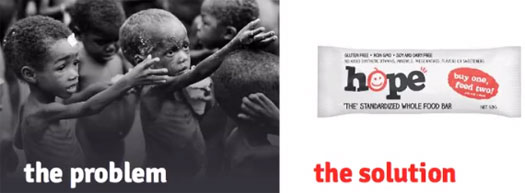
The Hope Bar is “THE” Standardized whole food bar. That means we use nothing but whole food ingredients enriched with nothing but food-sourced vitamins, minerals, proteins and fats.
Hope bars are one of the most nutritionally dense whole food products on the planet. And every time you choose to nourish yourself, our company will donate a Hope bar to a malnourished child.
As above, the Hope Bar is specifically targeted at “malnourished children”, with the intent being that this will factor into how the product is marketed (see above image).
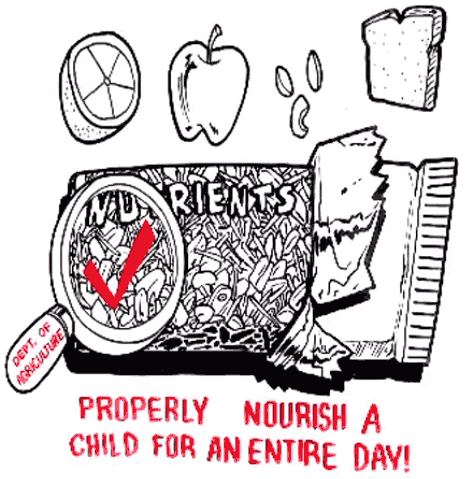
Purportedly, one Hope Bar provides satisfactorily daily nourishment for one child (up to 10 years of age).
No retail pricing for Hope Bars is provided on the EMSquared website, however I have seen affiliates marketing the bars as costing $2.50, equating one box of Hope Bars to $75 (30 bars a box).
For each box of Hope Bars purchased, EMSquared match it and donate the box for distribution through MannaRelief. MannaRelief is a separate company, launched by Sam Castor in 1999:
In 1999, Sam Caster and his wife Linda founded MannaRelief Ministries, a non-profit organization that provides nutraceuticals to orphanages.
For whatever reason, the above is not disclosed on the EMSquared website, despite the emphasis of “100% transparency” on the company website page MannaRelief is mentioned:

The EMSquared Compensation Plan
Foreword: The EMSquared compensation plan in its current format is quite confusing, with the company going out of their way to replace typical MLM terminology with charity jargon.
I’ve done my best to make sense of it below and explain it in a relatively straight-forward matter below, but it may need to be revised at a later date. /end foreword
The EMSquared compensation plan revolves around affiliate acquiring hearts, the acquisition of which is tracked through a unilevel style compensation structure.
A unilevel style compensation structure places an affiliate at the top of a unilevel team (level 1). If any of these level 1 affiliates go on to recruit new affiliates, they are placed on level 2 of the original affiliates unilevel team:

If any level 2 affiliates recruit new affiliates, they are placed on level 3 and so on and so forth. There is no limit to the width or depth of a unilevel team, with level 1 expanding out as wide as the number of affiliates are personally recruited. The depth of the unilevel team expands down however many generations of recruitment take place.
Note that each level 1 recruited affiliate leg is independent of the others.
In EMSquared, the company makes the following definitions for the following level 1 recruitment legs:
- the level 1 unilevel leg with the highest production of Hope Bar box purchases is referred to as the “Giving Team”
- all other unilevel legs are referred to as “Reward Teams”
Heart Points Acquisition
Keeping in mind that one heart point in the EMSquared compensation plan equates to $1, affiliates are paid based on their personally acquisition of heart points and that of their recruited downlines.
The best way to explain the acquisition of hearts I feel is via an equation. Here are the components of the Heart Points acquisition equation:
- Personal Heart Points are obtained at a rate of 3 hearts after an initial four boxes of Hope Bar box sales are generated by an affiliate (including personally acquired donor and supporter purchases)
- Reward Team Heart Points are the collectively accumulated Heart Points generated by an affiliate’s Reward Teams
- Giving Team Bonus Points is matching point bonus that generates the point value generated via Reward Team Heart Points against the total points generated by an affiliate’s Giving Team (note that if the Giving Team’s total point generation is less than the Reward Team Heart Points, the amount of points generated in Giving Team Bonus Points will not exceed 100% of the points generated by the Giving Team)
- Per Child Points are derived from the total number of boxes (children fed) purchased or sold by an affiliate’s Reward Teams
Thus the equation for an affiliate’s monthly heart points is as follows:
Personal Heart Points + Reward Team Heart Points + Giving Team Bonus Points + Per Child Points = an EMSquared affiliate’s monthly heart points.
To further illustrate heart point generation, I’ve include the following diagram below from the EMSquared compensation plan:

As you can see, the total using the above equation is 1118 points for this particular month (dark blue circle). This is confirmed with the point value given in the non-cropped compensation plan slide (blue circle):
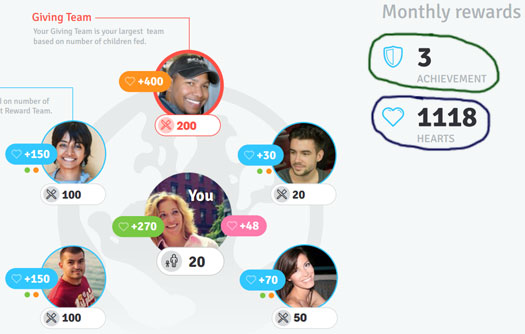
A note on the achievement level in the above example (which is 3, in the green circle). In the EmSquared compensation plan material, 9 affiliate levels are provided with corresponding payouts (ignore the “Hero” payouts for now, we’ll discuss those later):
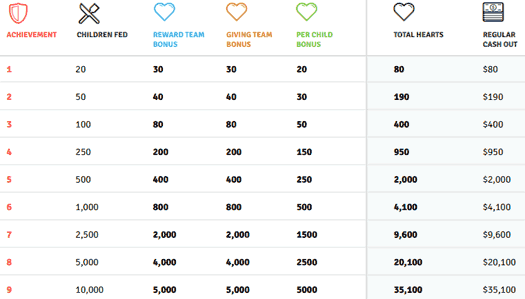
I initially thought that these might restrict affiliate payments, however that does not seem to be the case. In the level 3 example above, the 1119 heart points figure clearly exceeds the 400 total hearts figure cited. Ditto on the payment.
I then thought perhaps they were used to limit the counted heart points from any given Rewards Team, however in the level 3 example above, the bottom right Rewards Team is generated 70 heart points over a cited 50 boxes of Hope Bars.
In the level chart above, 30 boxes puts that Rewards Team at level 3. Try as I might, I couldn’t get 80, 80 and 50 to equal 70 in any combination. My conclusion is that the 70 figure is a result of that Rewards Team being between levels 3 and 4, with only the level 3 Hope Bar requirement being shown in the example, and not the actual number of boxes being shown.
EMSquared mention that an affiliate’s own rank is determined by the rank of their highest ranked Rewards Team, so there’s likely to be some significance, even if the company isn’t explaining what that is at this point in time.
If anyone has any other ideas, feel free to leave a comment because at this point I’m a bit stumped. Other than bragging rights, I’m currently unclear on how the EMSquared levels fit into the compensation plan.
Hero Status
Hero status within EMSquared increases the Heart Point value from $1 to $1.50 per point.
An affiliate can acquire EMSquared status by spending $499 on a “Hero Pack” when they join EMSquared, or by purchasing or personally generating the sale of 30 boxes of Hope Bars within a rolling thirty-day period.
In the above level 3 example, a regular EMSquared affiliate would earn $1119 for the month. If that affiliate had Hero status, they’d earn $1678.50.
Note that affiliate presentations cite the cost of a Hero Pack at $499, however the EMSquared compensation plan material states it’s $375. Given the affiliate advertising appears to be more recent, I’m inclined to go with that figure for this review.
Hero Pack Recruitment Incentives
There are two primary Heart Point incentives to promote the recruitment of EMSquared affiliates who purchase a Hero Pack when they sign up:
- 25 Heart Points are paid out to the recruiting affiliate everytime a newly recruited affiliate purchases a Hero Pack
- a further 175 Heart Points are paid out for every three newly recruited Hero Pack purchasing affiliates, counted within any given 90 day rolling period
Note that in order to qualify for the above incentives, an EMSquared affiliate must themselves be Hero Status qualified.
Joining EMSquared
Basic affiliate membership to EMSquared is $49 annually.
Hero Status affiliate is $499 (possibly $375 according to the EMSquared compensation plan).
All EMSquared affiliates are required to spend at least $75 on Hope Bars a month for commission qualification.
Conclusion
In order to fend off the expected “what about the children?” charity excuses, I’ll preface by stating there’s absolutely nothing wrong with donating boxes of nutrition bars to impoverished children.
That part of EMSquared is perfectly fine.
The red flags arise, as they typically do with any charity MLM, when you go over the business opportunity side of the business.
In MLM you need to have retail sales and to that end EMSquared have donor and supporter customer classes. Both have nothing to do with the compensation plan and both count as retail.
Yes the products purchased can be given away but money wise revenue is being generated from non-participants and a product is being bought (regardless of whether it’s ultimately donated to charity or not).
The legitimacy of EMSquared as an MLM business opportunity primarily hinges on the success of the company in attracting a large number of supporter and donor customers/donators (whatever you want to call them). The revenue these two classes generate for the company has to be larger than the affiliate base, or we run into problems.
If we separate the charity-side of the business, failure to attract a significant number of supporter and donor customer classes results in the majority of revenue paid out in commissions being sourced from affiliates and paid out to those who recruit the most.
Short of the charity smoke and mirrors, that would leave absolutely no difference between EMSquared and your run of the mill recruitment-driven pyramid scheme.
The key question then becomes how viable is it to expect people to pay $75 a month or more to donate without the attached business opportunity?
With all purchases being commissionable, and adding to that company expenses, naturally EMSquared are going to run at a higher overhead than a dedicated charity. Are non-affiliates going to be prepared to bear the brunt of those additional costs?
Surely a competing charity without the MLM overhead would be able to provide nutrition to more kids dollar for dollar?
And that brings us to one of the core issues with combining charity and MLM. Does the charitable component of the business opportunity exist on its merit alone, or is it simply there in an attempt to justify what is otherwise a recruitment numbers game?
Again, the existence of a large number of donors and supporters would confirm perceived value in the charitable aspect of the business. That unfortunately cannot yet bet judged until at least a few months in (EMSquared has only just prelaunched).
On the affiliate side of things, the motive behind the monthly commitment is a core issue the same as with any other MLM business opportunity.
Psuedo-compliance wise, the scripted answer to the question is “I buy umpteen boxes of Hope Bars and have recruited others because I care about the children”. Be that as it may, let’s take a look at things from a regulatory standpoint.
To their credit, EMSquared permit an affiliate to donate their Heart Point commissions to one of their approved charities. As such, this becomes the defacto measuring stick for any affiliate who claims to be in the business opportunity “for the kids”.
If they’re donating their commissions, then and only then can they be believed. Otherwise the motive behind their participation becomes decidedly murky.
From a regulatory standpoint though, things are a simple. Affiliates join EMSquared, recruited a bunch of people and, as long as everyone keeps up their monthly minimum payments, make commissions.
Whatever the claimed reason for participation and purchase of Hope Bars, unless commissions are being donated to charity, one cannot discount the possibility of an affiliate being in it for the money.
Why is that problematic?
We then enter the scenario of a recruitment-driven scheme (defacto or otherwise), being marketed on the merits of charity.
Here are two real-world examples illustrating this exact point. The first is from EMSquared themselves, by way of a corporate marketing video:
Imagine for a second there are kids around the world that are eating meals that have absolutely no nutrition, some of them sick and even dying, you can now make an impact and be their hero by simply enjoying the bar yourself.
Now imagine those same kids playing, having fun and being happy (Ozedit: and not dying…).
And here’s an EMSquared affiliate, instructing potential recruits on what to say when they market the business over the phone:
I’ve just committed to a social giving cause called the EMSquared project. I’m super excited about it, it really stands for eradicating malnutrition in children around the world by squaring the efforts of others.
I’ve personally committed to feeding twenty children each month. I’m gunna send you a short video, I think it’ll tug at your heart-strings the way it did mine. And then I just wanna see if you’d be willing to help support me in feeding these twenty children.
In both cases, we’re looking at extremely manipulative marketing being used to market an MLM opportunity. What do you think most people are going to say when an EMSquared affiliate places the responsibility of dying kids at their feet, or makes them watch emotionally manipulative videos and then tells them 20 kids will starve if they don’t hand over cash?
EMSquared haven’t even launched yet and yet the tone for advertising the business opportunity has already been set:
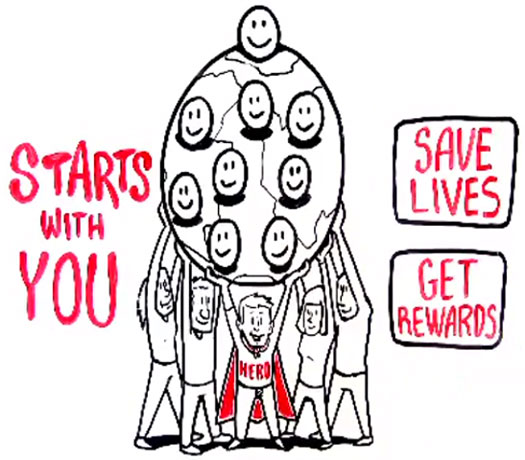
“What? You don’t want to join?! Why do you hate starving kids? Have fun sleeping at night knowing that kids are dying because of your decision.”
To be fair, it’s not just EMSquared who suffer from this. Pretty much any MLM charity exhibits the same problem in their affiliate marketing – and this is precisely why the marriage of charity and MLM is generally not a good idea.
Similar arguments and flawed reasoning will naturally be brought up against anyone who voices even the slightest concern or criticism of the business model. Ultimately though, whatever charitable causes an MLM company attaches itself to, they are still bound to the same rules and regulations as any other company.
Action A (charity) does not excuse of nullify what goes on in Action B (the MLM business).
As for the whole Hero Status thing, there’s definitely some pay to play issues there (paying more when signing up directly influences Heart Point dollar values).
A EMSquared affiliate can of course hit Hero Status by generating the sale of or purchasing thirty boxes of Hope Bars in 30 days, however it’s far more likely they’ll just pay $500/$375 when joining.
It’s obviously likely that the prospect of trying to make back the initial cost via the recruitment of other Hero Pack purchasing affiliates will outweigh the incentive to generate 30 Hope Bar box sales in 30 days.
If you want to help malnourished children, by all means sign up to EMSquared as a supporter or donor but be aware of dollar for dollar where your money is going. I’ve personally yet to see a breakdown of the cost of two boxes of Hope Bars and how much of the $75 is paid out in MLM commissions.
Regardless, I find it hard to believe they can compete with a charity that does not have these liabilities… and that leaves with the MLM business opportunity in which affiliates are trying to sign up new affiliates and ignoring the other two customer classes.
One final note, I’ve seen Michael Rutherford’s name attached to EMSquared as an affiliate:

Rutherford and a few other presumably master distributors in EMSquared went down to Mexico a few weeks back to hand out some Hope Bars at orphanages. Rutherford’s involvement in EMSquared isn’t a red flag in and of itself, but it should be noted he was the master distributor for the failed MLM venture Rippln.
Rippln’s corporate lawyer Jenifer Grace is also on board, and is listed as “general counsel” for EMSquared on their “privacy policy” page:
Grace has a history of representing ventures Terry LaCore is involved in (she’s also general counsel of bHip Global). During her time as Rippln’s general counsel, she issued at least one statement as a spokesperson for the company.
Whether any of the Rippln crew beyond Rutherford and Grace are involved in EMSquared is currently unclear. Sam Castor/Caster appear to be independent of Rippln so Grace and Rutherford’s involvement could just be co-incidental.
I did observe the word “gamifcation” being thrown around in EMSquared marketing presentations though, which is a word anyone even vaguely aware of Rippln should be familiar with.
Beats me how you turn the supply of nutrition to malnourished kids in Mexico into a game though… anyone?


Call me cynical, but I just think some adults act like wayward teens by doing anything that attracts the authorities to get involved in just about everything they do.
Somehow, they can’t seem to get it right.
Wasn’t there ANOTHER of these “give supposedly nutrition packs to starving children” MLMs around a few months ago? I remember you reviewed one such, Oz.
Not to harp on Sam Castor too much, but he’s also the one who touted a bogus doc’s bogus study to “prove” Mannatech’s product works. He later sic’ the Mannatech lawyers on the doc for making him look really stupid. 😀
Hidden Hunger used “micronutrient packs”. Apparently they’ve rebranded sometime recently though. Got them flagged for a review at some point.
Club Asteria made similar claims
No sign of charity licenses or permits or proof of delivery of Hope bars anywhere I can find.
IIRC Manna Relief was a part of Texas AG’s indictment back in 2007. Is it still run by McDaniels?
Terry Lacore is co-owner of EmSquared along with Sam Castor. Brian Underwood is also involved at the highest level.
Based on Sam’s history, does anybody believe this is legitimate?
Sounds like Sam used his 5 years off to dream up a creative spin on a new type of MLM scam. I can hear it now, “But judge, we don’t have to have retail customers, we’re giving all of the products away to hungry children around the world!” If audited, I doubt they will be able to prove shipments of these products.
However, one must congratulate Sam on being creative during his “down time.” If the products are actually shipped to hungry children (and what a heart-tugging issue that is, how can you POSSIBLY question Sam’s motives over hungry children – for shame! LOL), how is this different than a typical charity that has paid staff to find new sources of money and contributors?
You really have to hand it to Sam for being creative.
Another sure sign of the connections to the Rippln scam is that Michael Beal (a major pimp for Rippln) is involved in this.
@Tex
Typical charities aren’t MLM companies. Furthermore a charity is registered as such, EMSquared will be registered as a for-profit business.
@Jeff
I guess this means Vapt is officially dead then?
Typical charities have national coordinators, who are paid more than the regional coordinators, who are paid more than the state coordinators, who are paid more than the local coordinators. I understand this isn’t MLM, but the distinction has trivial differences.
Now they have the former president of Mexico on board: http://theem2project.com/
Where did you get the above graphics describing the EM2 business from?
I’m pretty sure I saw some 501c3 designations on some of the research I did yesterday, but can’t find it now. You do know many non-profit charities pay their people VERY well, right?
Here we go: http://www2.guidestar.org/organizations/75-2809600/manna-relief-ministries-sam-caster.aspx
And here’s a link right on their website: http://www.mannarelief.org/index.cfm?id=085606ab-6823-4427-89f218d11d0954f8&about.html
@Tex
They were from the EMSquared compensation plan.
Where can I find that?
If the crooks from The “Company” Formally Known As Rippln are involved – they’re not as interested in filling stomachs as they are WALLETS! RUN from these crooks and don’t give this “opportunity” a second look!
Scammers gotta scam, I guess. The plan with Vapt seemed to be to use the app to recruit, and keep all communications in the app… Problem is, nobody was downloading the app.
From a cursory look… Are we sure EMSquared is the name of the company? Because there are a few companies with that name or variants.
iControl Studio is awful, which fits with the usual scammer M.O. of operating for as little money as possible. (Rhinosupport, lol!)
What I don’t get is… If I was to buy the bars, and they’ll match a box to be donated… What happens to my box? What am I supposed to do with it? 🙂
Or was I supposed to mark it as “donation” as well, so I never get the box, just the bill, and they get 2 boxes?
I found the EMSquaredusa.com site finally.
The phone number on the site ( 816-885-2783 ) belongs to a former Kansas City real estate agent named Scott Lundgren, as does the email address on the contact page.
K. Chang, you can’t find anybody where you live who is hungry?
Probably this Lundgren, looks like h’e been in MLM before (Wealth Information Network): linkedin.com/in/scottlundgren
@Cheese
That’s an affiliate site. The company’s website is “em2d.com”.
@Kasey
You can either opt to donate your box or eat the bars yourself. That’s what’s presented on the marketing videos.
@Tex
They haven’t gone public with the comp plan yet.
So you had another source for the above graphics?
A reader sent them in when they asked for a review.
Thanks.
Here is the link to the comp plan: em2d.com/downloads/em2d-rewards-program.pdf
@Jason
Thanks for that Jason. Looks like they’ve already modified it against the copy I cited.
They removed most of the indepth explanations. That’s more of a vague summary than an actual compensation plan document.
I don’t think it’ll be very helpful to most prospective affiliates, which in favour of “what about the children?” marketing, I suppose it’s designed to be.
So is this somewhat like the Funds 4 Kids program way back around 1993 they did?
A friend of mine worked with Sam’s cousin or aunt, I forget which, (Frank’s wife) at Dr Donald Kelly’s cancer clinic up in Addison area just north of Dallas. Or was Funds 4 Kids a networking type program ?
@Pam
That’s going a bit back!
If Funds4Kids had an income opportunity attached it was probably MLM. If it was just a straight up charity then it was probably more in line with the more recent “Manna” stuff.
Total sleaze ball company. Rob DeBoer, another well-known snake-oil salesman/scammer is involved as well. That’s a big red flag in my book. His last scam was C=Prime Bracelets. Here are the details of the fines he had to pay for ripping people off on BurnLounge.
http://www.ftc.gov/news-events/press-releases/2012/03/ftc-action-leads-court-order-shutting-down-pyramid-scamthousands
Unfortunately, these dirt balls will probably make a ton of $$$ since a sucker is born everyday.
What the BurnLounge press release didn’t show is DeBoer was believed to have pocketed about 1 million, but FTC didn’t get enough dirt on him to make him cough up all of it.
I am… 😉
But if I give, I prefer a real charity, like my local Food Bank.
More good reasons to make MLM illegal. What I can’t figure out is how these food bars is illegal. Based on everything else I know about MLM, this is legitimate, but the operators are known and convicted scammers, so there’s got to be something fishy behind the scenes going on.
I won’t join anything Brian Underwood, Michael Rutherford or Mike Beal are involved with by any name or disguises. If its an MLM it will only help them.
Remember Rippln just a new name same racket MLM. If you really want to help give it to the Red Cross no angle there…
Hi, I like the idea of 1 for 1 products, like Tom’s Shoes, but I would much rather it stay simple, rather than MLM.
I personally dislike how MLM can muddy relationships and friendships. It quickly makes me think, am I your friend or a potential downline?
I kept looking for a link where I could just order some bars. Right now I eat a protein type bar every morning for breakfast, from Aldi I can get them for about 50 cents each. I maybe would pay a $1 or $1.50 if I knew one was donated each time to the poor, but $2.50 is too much.
I also don’t want to buy 30 bars before tasting them. If they would reboot this to be more like Tom’s shoes, or One World Futbol, I would be more interested.
Seriously there is always someone who wants to put down something and here we go again with the above. The deal for me is the project is the product here, and I think its awesome. 3 of my friends have joined me as Hero’s and I already have more than half my cost back $350. and paid.
I love the cause, love the product, and am focused on the cause of eradicating malnutrition. Call it social entrepreneurship, I can see how this form of MLM call it what you want, can have huge impact and I want to be part of it. Whats wrong with people getting paid to share word of mouth on a project like this.
MLM is the perfect way to get it done big. The only people who complain about MLM is those who never worked hard enough at it, and have no success because they didn’t learn and didn’t stick with it. I have 20 years of doing great and helping so many of my friends get ahead.
So you recruited three affiliates, and got paid for it.
Furthermore, you consider this a >50% recovery on your EMSquared entry cost.
But yeah, it’s “all about the children”.
Yet every charity-centric MLM has failed to take off. Whys is that I wonder…
Oh right, the recruitment focus of them.
(PS. Your recruitment spam was removed, please do not post it again)
Dave, the bars have to be expensive to make the company owners rich, and pay out the distributors.
Does anyone know what are the ingredients in these bars?
Not sure what you all think you have uncovered here.. but it’s ridiculous that this is being ridiculed the way it is and the majority of the things mentioned here and in the comments couldn’t be further from the truth.
MannaRelief is a completely separately run, independent nonprofit organization.. let’s get that clear. And in reference to the lawsuit a few years back, they were dismissed of all charges.
Also, employees at MannaRelief are NOT paid extensive salaries.. money is very tight and it is managed well. Feel free to check for yourself before you make accusations.
Second, Sam is not the monster people here make him out to be. I can’t convince anyone if they think otherwise but I’d suggest taking things with a grain of salt and not believing everything you read on the internet. Look at the personal things Sam has done in his life and make your judgement there.
Overall I think it’s sad that there are people out there looking to destroy anything and everything that might do something good. For anyone skeptical about the new company right now, wait it out and you’ll get your proof of their good will soon enough.
How about the Texas AG, seeing as that’s who Castor appears to have had most of his legal run ins with?
There’s nothing “good” about pay-to-play recruitment-driven schemes.
I was just approached to join in this “ministry”. I was told Sam is a Godly man and is trying to help these children.
I was very excited about it at first because I have a heart to help people. The money end of it didn’t even matter to me and I was told I could donate my profits if I didn’t want to keep it.
I thought I would be doing something good now after reading this I feel like I have been scammed. Any advice?
Advice k24?
Donate to your local charity…stay away from these p2p scams.
In their hearts, they probably actually believe it.
But you have to see past their intent, and what they BELIEVE is reality… to the ACTUAL TRUTH.
It may not be the same thing.
Thought long and hard before posting something here… I obviously decided to voice my humble opinion.
To be transparent and get this out of the way – yes, I joined EMSquared as a hero; once I found out all the facts and reviewed the company’s operation for myself.
From reading above – I now have roughly 15 people that just yelled out “Sucker!” to a computer screen… so be it, enjoy your next cocktail.
I’m currently a COO for a nice sized company and my wife also has a successful career. Between us, we have 3 Masters Degrees – we hardly fit into a “suckers” category.
Here’s why I joined:
When my three kids are asked “what does your daddy do”? They respond with “he makes money, he runs a company etc. etc”. What kind of a legacy and a life does that show them?
What if instead my family could respond with “my daddy feeds thousands of starving kids around the world”. My friends, now THAT’S a legacy to be proud of.
Giving to charity is simply not a sustainable model, it just isn’t. I can only feed so many malnourished children on my own. Yes, I could easily serve or give at a food bank (and we do that) but how many people do I really impact? a dozen, twenty, fifty?
Should I get cancer or run into a situation where I can no longer work and support a local charity, who will take my place?
To me, it makes perfect sense to build an army of people to help this cause. Further, it makes perfect sense to reward people’s contribution and efforts so they can help sustain their own families.
For the pundits:
From my calculations, the company has roughly 36% COGS, due to providing not 1 but 2 bars for each one bought/sold (protein & non-synthesized ingredients are very expensive).
They pay out another 50% in the rewards plan. That leaves a mere 14% to run operations, cover technology fees, pay salaries and hopefully squeak out a profit at some point in the future. Goodness, there are certainly more advantageous ways to make a lot of money…especially if your goal was to rip someone off.
Yes, Sam has had run-ins with the AG’s. So what? It happens. Anyone building a big business has had similar situations. Try Googling: Warren Buffet, Bill Gates or thousands of other business leaders and see what you find. Does that mean they are all scum?
Heck, if you work at a decent sized company (100 Mil+ annual revenue) Google them as well. What you’ll find may shock you.
Perhaps we should all just sit at home, check-out from society and collect welfare checks… that ought to fix all the problems.
Comment away, it matters not. I won’t be back to check.
I’ll be too busy living my life to the fullest, training my children in the way they should go and sharing EMSquared with others so my family can feed as many children as we can and make the largest impact possible.
I wish everyone in this thread a full and happy life.
^^ Cool story bro. How long’d it take you to pen that copy?
Right, someone who wants to “change the world” has no problem with 50% of revenue going to marketers instead of “starving” children.
I’m sure you can find a charity with more money going to “the cause” than 36%. But all that is bullshit smoke and mirrors, you’re just in it for the money.
What little goes to “the kids” just helps you sleep better at night.
I used to have a list of charities and how much of what they take in is actually given to the designated cause (that info is also available on some of the various charity’s websites), 50% is actually better than most!
To improve one’s income so that he can afford to improve his own health and that of a malnourished child at the same time doesn’t sound like too bad an idea to me.
However, I personally do not intend to buy this product because it is expensive, my income is low, I don’t know the product to know whether it would help me, (as someone stated, I’d like to try it before deciding to promote it), and I’ve never been good at MLM. But for those who are, more power to them!
Any updates to this info? I’m researching Sam Caster and Mannatech and came across this site.
I looked up “EMSquared” but they seem to have disappeared and I can find nothing about what ended up happening to them.
Did Caster take the startup money and disappear to the Caymans? Did they ever actually launch? When/how did they go belly up?
Their website is gone and all the links in the above comments do not work anymore.
I’m curious about Mannatech too, they seem to me to be a dying company. My mom joined in 1997 and was super active in it for most of the last two decades, going to the conferences and trainings every year and trying to sell and recruit constantly.
I grew up around it all. I met Sam Caster one year at MannaFest, and he prayed for me personally for my health problems (ask me about that sometime lol).
But I remember they used to talk about hundreds of thousands of associates, but according to the most recent income disclosure statement I could find (2019), which they have to release since they are publicly traded, they only have a total of under 36,000 associates.
And look at how few are in any leadership level at all. This looks to me like a dying MLM.
sequenceinc.com/fraudfiles/wp-content/uploads/2012/12/mannatech2019.pdf
EMSquared is long gone. Last I checked in Caster was running Alovea.
Ok thanks. But I’m just wondering how that happened.
Did it even launch or did it crash pre-launch? Was it shut down by regulators? Did they try to make a go of it but it didn’t take off?
Alovea seems very similar, did he just rebrand it?
EMSquared just died off. Didn’t go anywhere.
Alovea is Evolv Health renamed.